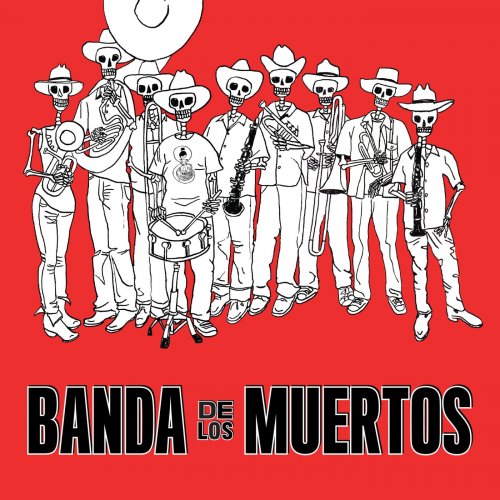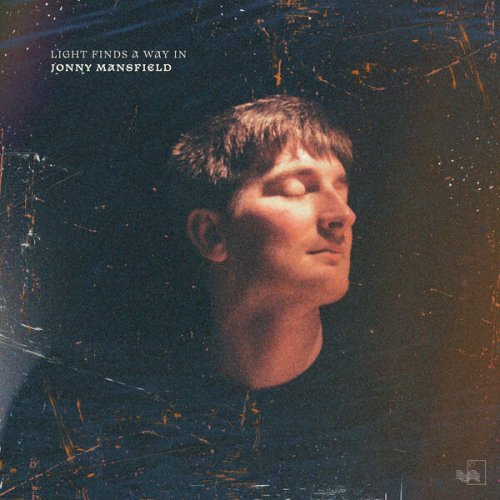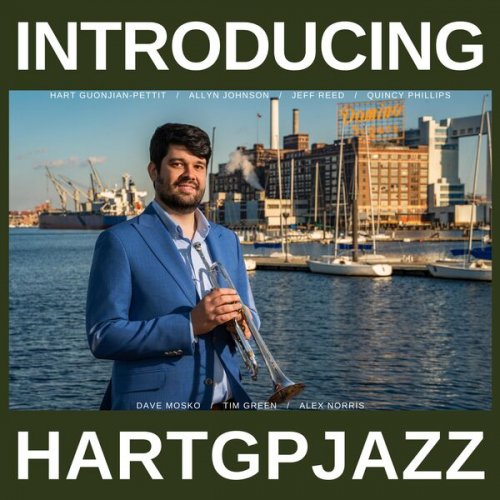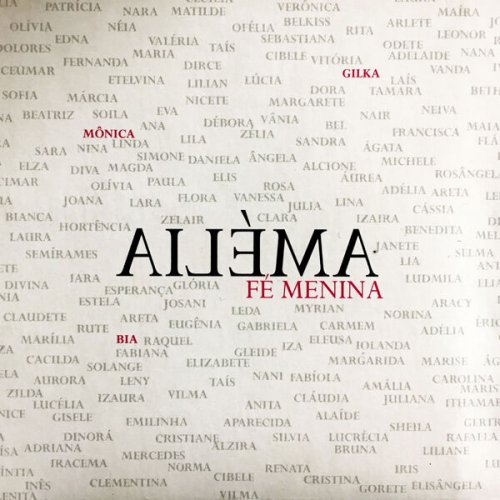Banda de los Muertos - Banda de los Muertos (2015)

Artist: Banda de los Muertos
Title: Banda de los Muertos
Year Of Release: 2015
Label: Barbès Records
Genre: world, chicha, cumbia
Quality: FLAC (tracks)
Total Time: 42:12 min
Total Size: 246 MB
WebSite: Album Preview
“Jacob and I want to dedicate this album to all of the immigrants, like my parents, who came to the United States from Mexico to start a new life, but who held on to their memories and to the music that they loved.” Oscar NoriegaTitle: Banda de los Muertos
Year Of Release: 2015
Label: Barbès Records
Genre: world, chicha, cumbia
Quality: FLAC (tracks)
Total Time: 42:12 min
Total Size: 246 MB
WebSite: Album Preview
For the past twenty years, Brooklyn residents Oscar Noriega and Jacob Garchik have kept busy in the jazz and classical world – Oscar is a sax and clarinet player known for his association with Lee Konitz, Paul Motian and Tim Berne; Jacob is an arranger for Kronos Quartet and a freelance trombonist.
A few years back, both Oscar and Jacob came to be obsessed with the brass band music of Sinaloa – the Mexican state now better known for El Chapo than its musical output. Oscar, the son of Mexican immigrants, felt a nostalgic connection to the music of his parents. Jacob, who had no prior knowledge of the music, was fascinated by the intricate arrangements, the dexterity of the brass players and the astounding virtuosity of its sousaphone players.
Realizing that there was no traditional Banda in Brooklyn, they decided to start their own. They wrote new arrangements, Jacob practiced sousaphone and they enlisted some of their musician friends, most of them players familiar to jazz audiences: Chris Speed, Jim Black, Curtis Hasselbring, Brian Drye, Ben Holmes Justin Mullens as well as French Horn player Rachel Drehmann and singer Mireya Ramos, of Mariachi Flor de Toloache fame.
Soon, Banda de Los Muertos was attracting an audience made up of Brass aficionados and Mexican immigrants – as well as kudos from the mother of all Mexican Brass Bands: Banda el Recodo.
In Mexico in general, and in Sinaloa in particular, brass bands (bandas) are part of every public celebration. In the 1940’s, the pioneering Banda El Recodo started mixing up traditional brass band tunes with contemporary Mexican music – mostly ranchera – and soon transformed the idiom into a powerful new popular genre. In the 1990’s, banda music experienced a renewal, especially among Mexican immigrants living in California, many of whom have family roots in Sinaloa. Banda music’s popularity exploded in Mexico as well.
Despite its popularity, Banda music remained (and remains) confined to the poorer neighborhoods of urban Mexico. It has gained little respect among “serious” musicians or established critics. That a band made of mostly conservatory trained musicians – such as Banda de Los Muertos – should play this music, was both surprising and inspiring to Banda fans in Mexico and the US.
Banda de Los Muertos’ debut album is a tribute to the early years of the genre, but also a re-interpretation of the Banda tradition. The band stresses the subtleties of the original music over the more hook-driven new hits that hold favor on contemporary Mexican radio stations. Jacob and Oscar’s original arrangements have a big band flavor that relies on the precise ensemble playing – but without ever giving in to the temptation of esoteric jazz improvisation. Banda de Los Muertos plays popular music – the kind of music you’re supposed to get married and break up to.
The track listing looks back to some Mexican standards – such as Jose Alfredo Jimenez’ Tu Recuerdo y Yo or Tragos Amargos, made popular by Norteño star Ramon Ayala – as well as Banda classics such as El Toro Viejo or El Sinaloense. Also included are a cover of Marty Robbins’ El Paso – a frontera song… – and Ecuadorian crooner Julio Jaramillo’s Ay Mexicanita. The opening track though, is an original cumbia by Jacob Garchik and Oscar Noriega – Cumbia de Jacobo. The album also includes Te Quiero Tanto, a song written by Susana Dominguez, who was Oscar’s grandmother. A song Oscar used to play with his brothers.
For Oscar Noriega, the connection to the music runs deep. “I was born in Tucson, I am Mexican. My mom is from Guadalajara and my dad from Sonora,” he says. “My grandmother played piano and wrote tunes. I would listen to her play when I was a kid. She was the only person to play music in my family.“
Throughout his childhood and teenage years, Oscar played in a band with his four brothers: Hermanos JOVEL. The repertoire included ranchera, boleros, cumbia and other classic Mexican tunes. The brothers used the money they made to buy clothes and school supplies. ““We kept busy, we learned a hundred songs and played every weekend.” Oscar Noriega ended up studying at New England Conservatory and then moved to New York where he made a career as a jazz musician.
Jacob Garchik grew up in San Francisco, but his whole family comes from Brooklyn. “I started piano at 5. Trombone at 10, then picked up other instruments along the way. I went to music school in New York city when I was 18, studied jazz and classical music but was always open to a lot of different styles – Gospel, Balkan music, Klezmer – absolutely anything that I liked, I tried to play.“
After graduating, Jacob started freelancing as Jazz trombone player and landed a job doing arrangements for Kronos Quartet. “I’ve done close to 50 arrangements for Kronos – of music from all over the world. I got to collaborate with Laurie Anderson, musicians from Mali, Korea, Azerbaijan, on all different kinds of projects.”
Both Jacob and Oscar were members of Slavic Soul Party, a Brooklyn Balkan Brass band. The similarities with Banda music hit Oscar and had him reminisce about the music of his childhood.
After hearing Banda records on a jukebox in a Taco joint, Jacob started researching the music and did a couple of arrangements of classic Banda tunes which Slavic Soul Party ended up adding to its repertoire. A couple of years later, Jacob and Oscar started Banda de los Muertos.
Los Muertos started doing a monthly gig at Brooklyn club Barbès. “When we first started playing, we’d see Mexicans show up at the club” says Oscar “a little shy at first, not sure if they were in the right place.” Soon enough, the band would witness Mexicans and Hipsters dancing together. “We’ve seen a lot of interesting things happening… “ adds Oscar, laughing.
Now, Banda de Los Muertos’ audience is about equally made up of gringos and Mexicans, an achievement they are clearly proud of.
Adding a Mexican singer along the way clearly added to their appeal. While Los Muertos had mostly been playing instrumental numbers, they added singing with the help of Mireya Ramos, singer and bandleader of New York’s popular all female Mariachi – Mariachi Flor de Toloache.
Los Muertos’ crowning moment was probably meeting Banda el Recodo in person. “They had seen a YouTube video of us playing at Barbès and loved it,” says Jacob,” And because they liked the band so much, El Recodo decided to shoot their new video at Barbès.” “We hung out with them during the shoot” adds Jacob, ”and I used the opportunity to pick their brains. They were super-nice, generous, experienced and told me about all the different styles, how they practiced, every last detail.”
The video El Recodo shot that day (Vas a Llorar Por Mi) has already been watched by 110 million people.
The two bands have stayed in touch and El Recodo is now talking about recording a tune written by Jacob and Oscar: Cumbia de Jacobo.
Next step for Banda de Los Muertos: touring Mexico.
Tracklist:
01. Cumbia De Jacobo
02. El Sinaloense / El Jalisciense
03. La Puerta Negra (feat. Mireya Ramos)
04. El Toro Viejo
05. Tragos Amargos
06. Culiacán
07. Las Nubes
08. El Paso
09. Te Quiero Tanto (feat. Mireya Ramos)
10. Ay Mexicanita
11. Tu Recuerdo Y Yo
12. Arriba Mi Sinaloa

![Nectar Woode - Live at Village Underground (Live At Village Underground) (2025) [Hi-Res] Nectar Woode - Live at Village Underground (Live At Village Underground) (2025) [Hi-Res]](https://img.israbox.com/img/2025-12/15/eiazyx7yigt2lhbv1tcd3eos6.jpg)
![Coco Chatru Quartet - Lost Christmas (2025) [Hi-Res] Coco Chatru Quartet - Lost Christmas (2025) [Hi-Res]](https://www.dibpic.com/uploads/posts/2025-12/1765719561_coco-chatru-quartet-lost-christmas-2025.jpg)
![Dave Holland - Emerald Tears (1977/2025) [Hi-Res] Dave Holland - Emerald Tears (1977/2025) [Hi-Res]](https://www.dibpic.com/uploads/posts/2025-12/1765891427_cover.jpg)
![Rachel Kitchlew, SFJ - Flirty Ghost (2025) [Hi-Res] Rachel Kitchlew, SFJ - Flirty Ghost (2025) [Hi-Res]](https://www.dibpic.com/uploads/posts/2025-12/1765896408_qvf41hr1ljj8a_600.jpg)
![Betty Carter - The Music Never Stops (2019) [Hi-Res] Betty Carter - The Music Never Stops (2019) [Hi-Res]](https://www.dibpic.com/uploads/posts/2025-12/1765896843_bcmn500.jpg)


